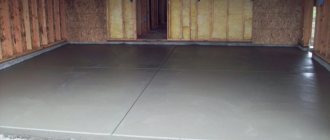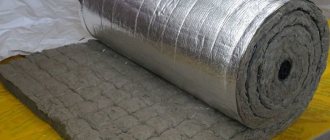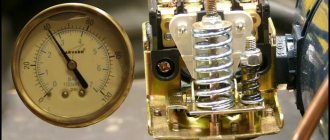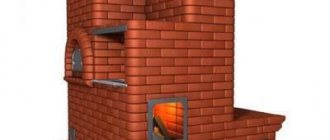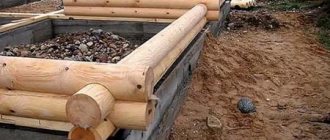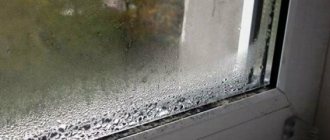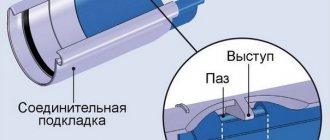What is the mechanism of a pumping station
To understand why the pumping station does not turn off, you need to familiarize yourself with the elements of which it consists:
- Directly pumping equipment. It is divided into submersible and surface devices. They branch into different types according to performance and are capable of operating in several modes.
- Hydraulic pressure accumulator. Presented in the form of a container, which is divided into two parts using fairly flexible rubber. When the pump is turned on, this container is filled with water and the rubber is stretched. When the mechanism is turned off, everything returns to its original position, and the collected liquid helps maintain a stable pressure in the pipeline.
- Control node. It includes a pressure gauge; it measures the pressure available in the system. Thanks to the presence of auxiliary elements in the installation, the maximum and minimum pressure values are set. When the highest level is reached, the pump receives a command to operate, and when it reaches the lowest level, it is turned off.
Why does the pumping station need to be turned off?
It is noted that one of the most common problems is that the pumping station does not turn off. The essence of combining all the parts that make up the station is that they regulate its periodic shutdown and timely operation.
Thanks to this, the service life of the pumping station increases significantly, and the number of wear parts is reduced. Some types of this equipment have an electric motor and are therefore completely unsuitable for continuous operation.
If you notice that your pumping station is working without a break, you need to stop the device and try to find out the root of the problem.
What causes the failures?
If the pump cannot lift water, external factors often contribute to this:
External malfunctions in the pump.
- A decrease in the fluid level in a hydraulic structure; in this case, the unit initially pumps water poorly, and soon ceases to perform its function, running idle. At the same time, the wear of the device increases, it quickly fails, since there is no provision for dry operation.
- The depth of the hydraulic structure is insufficiently large (up to 8 m), this becomes a cause of failure if the groundwater level decreases. With small well sizes, such changes are more noticeable.
- If you plan to install a pumping station on the site, it is possible to install a filter element. It is located at the inlet of the system - attached to the supply pipe at the bottom of the hydraulic structure and is constantly in contact with contaminants (sand, lime, substances contained in water). If you do not clean the filter, the water will stop rising.
The power of the electric motor was insufficient
If the force of the created water pressure was small initially, there is a high probability that the equipment was selected incorrectly due to an erroneous calculation of its power. As a result, the pumping station becomes ineffective: water is often absent or supplied intermittently.
When calculating the power of a device, a reserve is always made (10-15%), which will compensate for errors and the impact of negative factors during operation.
If these nuances have not been taken into account, the unit operates at the limit of its capabilities: it often turns on and off or operates continuously, which leads to rapid wear and malfunctions. At best, the device requires repair, and at worst, it fails.
The most common cause of station malfunctions
Most often, the pumping station does not turn off precisely because of breakdowns in the coordination of the control unit. In the main part of the main components of the pumping station, the degree of pressure is coordinated using two springs, large and small, which are located on the relay. The task of the large spiral is to regulate the lower pressure threshold, and the small one regulates the difference between the maximum and minimum values. It is also worth noting that during use of the pumping station control unit, it may become clogged, which significantly impairs its functioning.
Since there is a hole in the middle of the relay, during operation, and especially if all the pumped water is heavily contaminated, it can become clogged. Therefore, before starting to coordinate the main assembly, it is recommended to review the available relay parts and, if there is a need, carefully clean the input hole.
It is important to note that the relay must be adjusted very carefully. If you apply excessive force, you can permanently break the device. To make it easier to fix existing problems, the above assembly should be partially disassembled. To perform these steps, it is recommended:
- disconnect the station from the electrical network;
- liquid is drained from the battery tank;
- an ordinary pump from a car is connected to the inlet valve of the accumulator, always with a pressure gauge;
- the pressure required for the operation of the station is created in the accumulator tank;
- remove the cover that blocks the passage to the control unit that controls the relay - as a result, access to the springs will be gained;
- to increase the minimum pressure, you must turn the adjusting screw clockwise, and to decrease it, turn it counterclockwise;
- To adjust the difference between the lowest and highest pressure readings, this can be done by turning the adjustment screw.
It should be noted that the maximum pressure at which the station must be turned off must be at least 95%.
Clogged inlet filter
If the pumping station for your home does not turn off, you need to look for the reason not only in the drop in the liquid level, but also in the pump itself. In particular, in the intake pipe, a special filter is placed on it. It should be noted that a huge number of different particles can be found in water - clay, silt, sand; if they get into the pumping station, its elements will wear out. Therefore, a filter is installed at the inlet - this is where all the dirt accumulates, and it does not enter the system further. As a result, such a small element can significantly increase the service life of the pumping station.
But sometimes the incoming pipeline breaks down - in this case the station will also operate constantly without shutting down. And this, by the way, is a big load on all its components. If the filter is clogged or the pipeline is broken, it is necessary to eliminate these breakdowns as soon as possible. If the filter is clogged, it needs to be cleaned. If you want, install a new one, it will last much longer than the old one. Then, as in the previous case, you need to unscrew a special bolt, pour water through the hole and start the engine. Of course, you tighten the bolt before starting.
Additional reasons
There are several other less common reasons why the pumping station does not turn off for a long time:
- Water leakage is observed. To fix this, you need to find the damaged area and solder it.
- Failure in the electric relay unit. During operation, contacts may become dirty, oxidize, and sometimes even burn. This causes the pump to turn on and off frequently. To eliminate the malfunction, it is recommended to turn off the power to the device and thoroughly clean all contacts.
- And also the pumping station often turns on due to unstable voltage in the network. In this situation, it is advisable to purchase a power stabilizer.
In addition to the above options, constant operation of the device can be caused by air leaks in the inlet pipe. This will cause the pump to never turn off.
There is also an emergency drain valve at the pressure source. When a critical point is observed, it is activated to eliminate the breakdown of the device.
Occasionally, the pump may stop functioning or run continuously as a result of exposure to temperature, excessive heat or cold. This happens with devices that are not used constantly.
Regarding the cost of repairing a station, it should be emphasized that in the event of a serious breakdown (engine combustion), it will be cheaper to purchase new equipment. This is especially true for situations where the pump was purchased for 5–6 thousand rubles. If the equipment is still expensive, then it is better to change the engine rather than spend huge sums on purchasing a station. Other parts are less expensive:
- prices for a pressure gauge vary in the range of 200–500 rubles;
- a check valve costs from 100 to 500 rubles;
- The battery can be bought for approximately 750 rubles.
As a result, I would like to note that a station breakdown can be caused by a huge number of different reasons. But the most common problem is incorrect regulation of the automatic unit of the device. Provided that it is installed well, all operating rules are followed and simply handled with care, the station will last a long time.
Each of the above problems can be easily fixed with your own hands, but it is advisable to seek help from specialists in order to prevent the situation from worsening. It is better to pay a little money for repairs than to install a new station.
Impeller destruction
Why doesn't the pumping station turn off yet? The reason may be due to the fact that the impeller is destroyed and becomes unusable. Quite often, wear of pump parts is the reason that the entire system does not shut down. The power unit has an impeller - it is this that creates the fluid pressure. But if sand or any other abrasive gets on it, destruction will begin. And if you consider that some manufacturers install plastic impellers in pumping stations, the damage can be critical. It is much better if the impeller is made of light alloy.
But still, even if the impeller is made of metal, the material will be destroyed. Abrasive particles enter the system, causing significant wear of all elements without exception. This happens because the specialist who drilled the well is incompetent in this area. He incorrectly selected the mesh for catching sand or did not install a filter on the inlet pipe of the station. It should also be noted that the particles have different sizes. And they can be absorbed even through the filter (very small particles).
Construction of a pumping equipment complex
In order to understand what malfunctions can occur in a complex of pumping equipment when organizing pumping water supply, and how to correct them, you need to know the composition of the devices and the order of their operation.
You may be interested in information about how the Aquarius pump works
Pumping stations consist of the following components:
- pumping equipment itself . Depending on the characteristics of the water supply source, pumps can be submersible or surface pumps. They can have different operating modes and power;
- hydraulic pressure accumulator . This unit is a container that is divided into two parts by a partition made of flexible but durable rubber. When the pumping device operates, the container is filled with water and the rubber partition is stretched. When the pump stops operating, the partition tends to return to its original position and returns the water accumulated in the container to the pipes, maintaining the pressure in the water supply pipelines at a constant level;
- control unit . This unit consists of a pressure gauge that measures the pressure in the system. Mechanical parts in the control unit set the minimum and maximum pressure values. When the minimum indicators are reached, the unit gives a command to turn on the pump, and when the maximum indicators are reached, the pumping equipment is turned off.
The water level has dropped
Underground sources are depleted due to falling groundwater levels. An insufficient amount or complete absence of liquid leads to the fact that the equipment of the pumping station is operated empty, dispersing dry air.
To solve the problem, it is recommended to drill a deeper shaft.
As an alternative, it is possible to place the suction pipe several meters below the original location.
The drop in water level inside the pump is compensated by adding liquid to the nominal amount specified in the instructions for the unit. For topping up, there is a special hole in the device body, closed with a bolt. The fastening element must be unscrewed. The manipulations should be completed by restarting the pump. Acceleration of the startup process is achieved by turning off the station again and adding water.
Troubleshooting the pumping station
One of the common malfunctions of a pumping station is its constant operation. The essence of combining a pump, a pressure accumulator and a control unit into a single complex is that the pumping device operates periodically, when the minimum set pressure indicators are reached.
This mode of operation can significantly extend the service life of pumping equipment and protects its components from excessive wear. Some pumps cannot operate continuously at all - this is due to the specific characteristics of the electric motors.
If the pump included in the station does not turn off and starts working constantly, it is necessary to stop the equipment and try to find out the cause of the malfunction. The constant operation of the pumping station “for wear and tear” can be caused by various factors. Let's take a closer look at them.
Incorrect pumping station adjustment
Perhaps the most common cause of malfunction of the pumping station may be incorrect adjustment of the control unit.
In most control units in pumping stations, the minimum and maximum pressure levels in the system are adjusted using two springs: large and small, located directly on the relay:
- a large spring is intended to set the lower pressure threshold in the system;
- a small spring is responsible for the difference between the minimum and maximum values.
In addition, during operation, the control unit of the pumping station may become clogged, which negatively affects its operation. So, there is an inlet hole in the relay housing. During operation, especially if the pumped water is significantly contaminated, it may become dirty. So before you begin adjusting the control unit, simply inspect the components of the control relay and, if necessary, carefully clean the inlet hole.
Adjustment of the control relay must be approached with caution. This is a rather “thin” device and forceful interference with its operation can lead to additional damage.
In order to be able to adjust the automation unit of the pumping station, it must be partially disassembled. To adjust the device, perform the following steps:
- disconnect the pumping equipment station from the electrical network;
- drain all water from the pressure accumulator tank;
- connect a household or regular automobile pump with a pressure gauge to the inlet valve of the pressure accumulator;
- create working pressure in the hydraulic accumulator tank;
- remove the cover that blocks access to the control unit of the monitoring relay - you will gain access to the springs.
The minimum pressure in the system (once reached, the pumping equipment is turned on) is set by a large spring. Turn the adjusting screw clockwise if you want to increase the minimum threshold and counterclockwise if you want to lower the threshold.
Having adjusted the minimum threshold, proceed to set the difference between the minimum and maximum pressure. This indicator is determined by turning the adjusting screw of the small spring of the control relay. Turn the screw clockwise if you want to increase the upper threshold and counterclockwise if you want to lower the upper threshold.
Please note that the maximum pressure value at which the pumping device should turn off must be 95 percent of the maximum permissible pressure in the system
The relay fitting is clogged
The pumping station engine may not be turned off through a malfunctioning relay. The initial settings of the automation may be lost after the water level in the well or borehole decreases, after which a certain amount of air enters the suction line. In this case, it is necessary to move the suction pipe slightly below the original level, pour water into the system and start the pump.
Relay circuit
In addition, the cause of the station breakdown may be the relay itself. The engine will not turn on or will run constantly due to damage to the spring, which is used to regulate the operation of the groups of contacts that turn the pump on and off. The spring may rust and stop performing its functions, and the contacts may simply close. When disassembling the relay, provided it is configured correctly, it is necessary to clean the contacts and, if necessary, replace the spring with a piece of a pin.
The pressure is adjusted by rotating special nuts in the desired direction. Excess or decrease in pressure is carried out according to the symbols on the device “+” or “-”. A clogged fitting also leads to improper operation of the relay. In the latter case, it is necessary to remove the device and thoroughly clean the inlet hole from accumulated dirt.
Other reasons for the constant operation of the pumping station
In addition to the incorrect operation of the control unit of the pumping equipment station, other reasons may be the reason for the device not turning off.
Hidden water leak. As a result of this malfunction, the pumping equipment will, under the influence of the control unit, constantly maintain the specified water pressure in the system. To fix this problem, you need to identify the leak and seal it. However, keep in mind that leaks can occur anywhere in the plumbing system.
In addition to adjustment problems, problems may arise in the electric relay unit. During operation, contact contamination, oxidation, or even burning of the surface may occur. To eliminate this problem, the device is de-energized and the contact surface is thoroughly cleaned.
Problems with constant switching on of pumps can also arise due to unstable voltage in the network. Measure the voltage on your power grid while the device is running and, if necessary, include a transformer or power stabilizer in your system.
Constant operation of pumping equipment can also be caused by air leaks in the inlet pipe of the device.
The pressure accumulator may have an emergency release valve. When a certain critical pressure level is reached, it is triggered to prevent equipment damage. Sometimes the settings of this valve can be lost, and then it releases pressure at low values. This deficiency is corrected by adjusting or replacing the valve.
As you can see, problems in the operation of a pumping equipment complex can be caused by a variety of reasons. The main factor influencing the unstable operation of the pumping station is incorrect adjustment of the equipment automation unit. This flaw can be corrected by almost anyone with minimal technological skills.
To learn more about the procedure for correcting deficiencies in the operation of pumping equipment stations, watch the training video.
Reasons for lack of pressure and how to fix them yourself
There is no single answer to the question why the pumping station does not gain pressure, and there is also no panacea to solve this problem.
It all depends on the reason for the failure. It is not difficult to identify it and repair the pumping station if you consistently “walk” along the entire path of the liquid and examine the equipment responsible for its circulation.
The water level has dropped
If there is not enough inflow in the well and well, then the pump pumps idle.
This cannot last long, and the electrical elements will eventually burn out. Those models that are equipped with protection will be disabled, which is also a reason to think that this is the problem. We will have to wait until the well is filled again, but in the meantime we need to use alternative sources.
The inlet filter is clogged
In this case, the pumping station does not turn off, but is operational. The only thing you need to do is clean the mesh from sand and clay. If the bottom of the well is silted, you will have to clean it. In any case, you need to remove the pump and make sure that this is the problem. Models with a built-in filtration system require periodic maintenance, which consists of washing the filter.
Air in the pump or air leaks
Deep pumps must be completely submerged in water.
If it peeks out, then it is not surprising that air is pumped into the system along with water. Check that the pump is lowered to the correct depth. And if the pumping station is located on the surface, then most likely there is a hole in the hose coming from the source through which air is sucked in. The depth of lowering the pump will also have to be double-checked so that it does not run dry.
Ejector or gasket problems
Low pressure may be due to a faulty ejector. This unit is equipped with some modifications of pumps to increase productivity and improve performance indicators. Its task is to increase the energy of fluid transmission through the pipeline by throwing in an additional system. But if the ejector water intake is clogged, it must be cleaned manually.
Impeller wear
The blades that swirl the flow in a centrifugal suction system must fit tightly to the glass, but at the same time the free rotation of the wheel, which rotates with the help of bearings, is ensured. Failure of at least one of them leads to jamming. And if it leaks through the gap between the blades and the body, the suction capacity will decrease. You will have to disassemble the pump and replace worn parts.
The relay fitting is clogged
Automatic shutdown is performed by opening the electrical circuit. This is possible using a special pressure switch. The assessment of operating parameters is carried out through automated measurement of parameters. If debris gets into the inlet fitting, the pressure switch will not operate when needed. The result is that the pump does not turn off. The solution is to clean the inlet hole of the pressure switch fitting.
Low voltage
Not all pumping stations are equipped with protection against voltage surges in the network.
The problem is that when there is a shortage of energy, it is turned on, but there is not enough power to maintain the required pressure. This means that the well pump can work, but its performance is not enough to squeeze water to the surface. It will not turn off unless equipped with a special electronic protection system.
The solution is to test the electrical network to determine whether it has sufficient voltage. To eliminate this problem forever, you need to connect a stabilizer to the circuit, which will protect the equipment installed in the house from surges and short circuits. Protective electronics only save the electrical part of the equipment from burning out. The stabilizer eliminates this possibility in principle.
Leakage in the system
If the pipes leading from the pump to the point of consumption have a break, it is the same as turning on a faucet and leaving it open. The pressure is distributed and is no longer sufficient for normal functioning of the consumer. To identify a leak, you need to go through the entire circuit, observing the wetness, and also checking all points at the time of closing. The repair consists of shutting off the ball valve and repairing the hole in the pipeline.
Weak pump power
This is not a breakdown, but rather the negligence of the homeowner when selecting equipment. There is no way to fix the problem; you will have to buy a new pumping station. The calculation takes into account the compliance of the passport capacity and the required flow rate of all consumers. This must be taken into account when organizing irrigation and to ensure water supply to a residential building.
For well pumps, the main indicators, in addition to productivity, are the height of the water column and the distance over which the equipment can transmit liquid in the horizontal plane. When calculating the water column, it is generally accepted that a pressure of 1 bar is enough to raise water to a height of 10 meters. But there must be a pressure of at least 1.5-3.5 bar in the pipeline.
Air got into the pipe
An air lock is the consequence of an incorrectly installed pipeline. A cavity may form in elbows, bends and other places that water pressure cannot push through. It is not difficult to determine in which area this happened, because before the airy area the pressure is too high, and after it there is none at all. The solution is to turn off the water supply, dismantle the system and reassemble it in a different configuration. If there is a problem and nothing is done, the situation will become regular. The consequence is pump failure.
Problems with the accumulator
If the system is equipped with a storage tank and there is water in it, but it does not flow from the tap, then the outlet valve is most likely clogged.
If a hydraulic tank is installed in the chain, but the lack of pressure may be due to insufficient air pressure in the bulb. You will have to disconnect the tank and measure it using a pressure gauge.
Devices with a diaphragm are dismountable, and a leaky unit can be replaced. The bulb can also be changed, but if you have to act in this way, then after finishing the work you need to pump exactly enough air into the air chamber so that the pressure is the same as indicated in the technical data sheet for the accumulator. It is taken into account that at the time of sale it contained not oxygen, but an inert gas.
